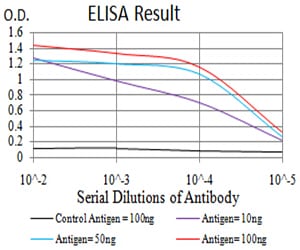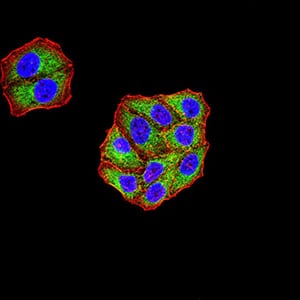


| WB | 咨询技术 | Human,Mouse,Rat |
| IF | 咨询技术 | Human,Mouse,Rat |
| IHC | 咨询技术 | Human,Mouse,Rat |
| ICC | 1/50 - 1/250 | Human,Mouse,Rat |
| FCM | 1/200 - 1/400 | Human,Mouse,Rat |
| Elisa | 1/10000 | Human,Mouse,Rat |
| Aliases | TSGA; JMJD1; JHDM2A; JHMD2A; JMJD1A |
| Entrez GeneID | 55818 |
| clone | 3G10C2 |
| WB Predicted band size | 147kDa |
| Host/Isotype | Mouse IgG1 |
| Antibody Type | Primary antibody |
| Storage | Store at 4°C short term. Aliquot and store at -20°C long term. Avoid freeze/thaw cycles. |
| Species Reactivity | Human |
| Immunogen | Purified recombinant fragment of human KDM3A (AA: 311-445) expressed in E. Coli. |
| Formulation | Purified antibody in PBS with 0.05% sodium azide |
+ +
以下是关于KDM3A抗体的3篇参考文献,内容基于公开研究整理:
1. **文献名称**:*KDM3A interacts with a SWI/SNF-related complex to regulate transcriptional activation via H3K9 demethylation*
**作者**:Yokoyama, A. et al.
**摘要**:该研究利用KDM3A特异性抗体进行染色质免疫沉淀(ChIP)和蛋白质相互作用分析,揭示KDM3A通过去除H3K9me2标记,与染色质重塑复合物协作调控靶基因转录,尤其在癌症中影响细胞增殖相关通路。
2. **文献名称**:*KDM3A is critical for the maintenance of embryonic stem cell self-renewal and pluripotency*
**作者**:Mimura, I. et al.
**摘要**:通过Western blot和免疫荧光实验(使用KDM3A抗体),作者发现KDM3A通过调控H3K9me2水平维持胚胎干细胞的自我更新能力,其缺失导致分化相关基因异常激活。
3. **文献名称**:*KDM3A inhibition suppresses adipogenesis by modulating oxidative phosphorylation and PPARγ activity*
**作者**:Dutta, A. et al.
**摘要**:研究采用KDM3A抗体进行染色质分析和蛋白表达检测,证明抑制KDM3A会干扰脂肪细胞分化,其机制涉及线粒体功能失调和PPARγ信号通路的下调。
4. **文献名称**:*The role of KDM3A in hypoxia-induced tumor progression through epigenetic regulation of metastasis genes*
**作者**:Pollard, P.J. et al.
**摘要**:通过免疫组织化学(IHC)和ChIP-seq(使用KDM3A抗体),该文献揭示了KDM3A在缺氧条件下促进肿瘤转移的机制,即通过去除H3K9me2激活促侵袭基因(如LOXL2和VEGFA)。
这些研究均通过KDM3A抗体验证了其在表观遗传调控中的功能,涵盖癌症、干细胞及代谢等领域。如需具体文献来源,建议在PubMed或Web of Science中按标题/作者检索。
The KDM3A antibody is a research tool designed to detect and study the KDM3A protein, a member of the lysine-specific demethylase family. KDM3A, also known as JMJD1A or JHDM2A, is an enzyme that catalyzes the removal of methyl groups from histone H3 lysine 9 (H3K9me1/me2), a post-translational modification associated with transcriptional regulation. By demethylating H3K9. KDM3A facilitates gene activation and plays roles in diverse biological processes, including spermatogenesis, metabolic homeostasis, hypoxia response, and cancer progression. Dysregulation of KDM3A has been linked to tumorigenesis, metabolic disorders, and infertility, making it a target for therapeutic exploration.
KDM3A antibodies are widely used in epigenetic and cancer research to investigate protein expression, localization, and interactions via techniques like Western blotting, immunoprecipitation, and immunohistochemistry. These antibodies are typically validated for specificity using knockout cell lines or siRNA-mediated knockdown. High-quality KDM3A antibodies help researchers explore its role in modulating chromatin structure, its crosstalk with signaling pathways (e.g., HIF-1α in hypoxia), and its potential as a biomarker in diseases like prostate cancer or liver cancer. Ongoing studies also focus on its involvement in sex determination and stem cell differentiation. Reliable antibodies are critical for advancing understanding of KDM3A's multifaceted functions in health and disease.
×